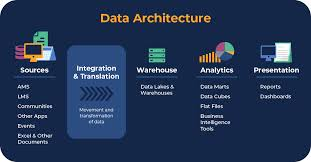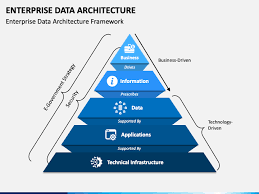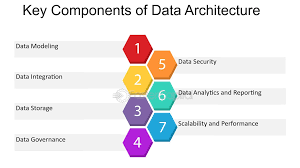A Comprehensive Guide to Data Architecture: Principles, Strategies, and Best Practices 2024

A Comprehensive Guide to Data Architecture: Principles, Strategies, and Best Practices 2024
Data architecture is the foundation of an organization’s data systems, defining how data is collected, stored, processed, and consumed to support business strategies. A well-designed data architecture ensures scalability, security, and efficiency while adapting to the rapidly evolving data landscape.
1. What is Data Architecture?

Data architecture defines how an enterprise structures its data assets to ensure business alignment, governance, and performance optimization.
✅ Key Functions of Data Architecture:
- Supports current and future data system needs.
- Adapts to rapid changes in data technologies.
- Guides data ingestion, storage, transformation, and access.
- Ensures compliance and data governance.
A. Definition of Data Architecture
Per industry frameworks:
- TOGAF (The Open Group Architecture Framework) defines data architecture as the structure and interaction of major data types, logical data assets, and physical data assets within an enterprise.
- DAMA DMBOK (Data Management Book of Knowledge) focuses on designing a master blueprint to manage enterprise data needs efficiently.
🚀 Successful data engineering is built upon rock-solid data architecture
The Role of Enterprise Architecture in Data Management

A. What is Enterprise Architecture (EA)?
Enterprise Architecture (EA) is the strategic design of IT and business systems to enable organizations to adapt to change efficiently.
✅ Enterprise Architecture includes:
- Business Architecture (business processes, strategy).
- Technical Architecture (IT infrastructure, technology stack).
- Application Architecture (software systems, services).
- Data Architecture (data models, integration, and storage).
🔹 Gartner Definition of EA:
EA is a discipline that proactively manages enterprise responses to disruptive forces by analyzing business and IT alignment.
3. Core Components of Data Architecture

A well-designed data architecture consists of the following layers:
| Component | Purpose |
|---|---|
| Data Sources | Collects raw data from databases, APIs, and sensors. |
| Data Ingestion | Moves data to storage (batch processing, streaming, ETL/ELT). |
| Data Storage | Stores data in structured/unstructured formats (Data Lakes, Warehouses). |
| Data Processing | Transforms raw data into meaningful insights (ETL, Big Data frameworks). |
| Data Serving | Provides access through APIs, dashboards, and applications. |
4. Types of Data Architecture
Data architecture can be categorized into two key perspectives:
A. Operational Architecture
🔹 Defines functional requirements based on business needs.
✅ Key Questions:
- What business processes does the data serve?
- How does the organization manage data quality?
- What are the data security and compliance requirements?
B. Technical Architecture
🔹 Defines technical aspects of data flow across the organization.
✅ Key Questions:
- How will data be ingested, stored, transformed, and served?
- What tools and technologies will be used?
- How will large-scale data movement (e.g., 10 TB/hour to a Data Lake) be handled?
5. Key Design Principles in Data Architecture
🔹 Mark Richards & Neal Ford’s Architecture Advice:
“Never aim for the best architecture, but rather the least worst architecture.”
✅ Best Practices for Data Architecture:
1️⃣ Flexibility – Architecture should allow easy adaptation to new technologies.
2️⃣ Scalability – Design for high volumes and velocity of data.
3️⃣ Governance – Implement access control, security, and compliance measures.
4️⃣ Performance Optimization – Optimize storage, retrieval, and processing speeds.
5️⃣ Data Quality Management – Ensure accuracy, consistency, and completeness.
🚀 Understanding the trade-offs in data design ensures efficient decision-making!
6. Understanding Data Flow in Architecture
Data moves through different stages in an enterprise. A well-structured data pipeline ensures seamless data flow from ingestion to consumption.
🔹 Example: Data Flow Architecture
1️⃣ Data Collection → From applications, IoT devices, logs, databases.
2️⃣ Data Ingestion → Using Kafka, Apache Flink, or Airflow.
3️⃣ Data Storage → Data Lake (S3, Hadoop) or Data Warehouse (BigQuery, Snowflake).
4️⃣ Data Processing → ETL (Extract, Transform, Load) or ELT (Extract, Load, Transform).
5️⃣ Data Serving → Access through APIs, BI dashboards, or ML models.
✅ A well-defined data pipeline enhances performance and reliability!
7. Choosing the Right Data Storage Strategy
Data storage decisions impact performance, cost, and accessibility.
| Storage Type | Best Use Cases | Examples |
|---|---|---|
| Data Lakes | Unstructured & raw data | Hadoop, AWS S3, Azure Data Lake |
| Data Warehouses | Structured, analytical queries | Snowflake, BigQuery, Redshift |
| Databases | Transactional workloads | PostgreSQL, MySQL, MongoDB |
| Streaming Storage | Real-time event processing | Apache Kafka, Pulsar |
🚀 Combining Data Lakes and Warehouses (Lakehouse Architecture) is a modern trend!
8. How to Align Data Architecture with Business Strategy
🔹 Steps to Designing an Effective Data Architecture
✅ 1. Understand Business Needs → Identify key data use cases.
✅ 2. Select the Right Technology Stack → Choose ETL, storage, and processing tools.
✅ 3. Optimize for Scalability & Security → Ensure data is safe and grows efficiently.
✅ 4. Implement Governance & Compliance → Follow GDPR, CCPA, HIPAA guidelines.
✅ 5. Continuously Improve & Monitor → Use observability and monitoring tools.
9. Future Trends in Data Architecture
🔹 Modern data architectures focus on scalability, real-time processing, and automation.
✅ Trending Approaches in 2024: 1️⃣ Data Mesh – Decentralized data ownership across teams.
2️⃣ Lakehouse Architecture – Combining Data Lakes & Warehouses.
3️⃣ Serverless Data Pipelines – Optimizing cost and scalability.
4️⃣ AI-Driven Data Engineering – Automating schema evolution & governance.
🚀 Future-ready architectures will be AI-powered and fully automated!
10. Final Thoughts
A strong data architecture is the backbone of modern data-driven enterprises. By following best practices, leveraging new trends, and ensuring scalability, organizations can efficiently manage and process data for long-term success.
💡 What challenges do you face in data architecture? Let’s discuss in the comments! 🚀